mobile View, to the German Version tap the flag


- former sovereign German state
- between 1352 and 1934 again and again dynastically and administratively divided
- since 1934 country of the German Empire, by merge of the countries Mecklenburg-Schwerin and Mecklenburg-Strelitz
• Flags
• Meaning/Origin of the Flag
• Coat of Arms
• Meaning/Origin of the Coat of Arms
• Map
• Numbers and Facts
• History
• Origin of the Country's Name
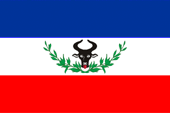
to ca. 1870,
Flag of the country with bull's head,
ratio = 2:3,
Source, by: Pierer's Universal-Lexikon
and Flags of the World



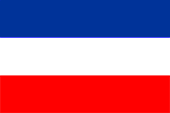
to 1918,
Flag of the country (colors),
ratio = 2:3,
Source, by:
World Statesmen



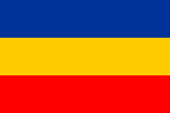
from 1863,
Landesfarben (colors of the country),
Source, by:
World Statesmen




1947–1952,
Flag of the Country of Mecklenburg in the GDR,
Source, by:
Flags of the World





The Duchy of Mecklenburg became for the first time divided in 1352, between two lines of the dynastic family, that happened again and again, so also in 1621 and at least in 1701. The Dukes – from 1814 Grand Dukes – of the two principalities shared not only their title, they also used the same coat of arms, and the same colours and flags. From 1755 there was even a common "Convening of Ranks" (a sort of parliament) for both principalities.
The flag of Mecklenburg was blue, white and red, which was used to ca. 1870 also with the bull's head, but also played the color combination of blue, yellow and red, a great role, initially only as a military colours. In 1863, blue, yellow and red were then introduced as colours of the country (Landesfarben), they could be used by anyone, even on flags, but there were also official flags introduced in these colours. But some flags remained in blue, white and red, even until 1935. The colours of Mecklenburg, blue, white, yellow and red, have their roots probably in the colours of the coat of arms of the rulers of Mecklenburg, because from the 14th century a quartered shield was used, which showed the various acquisitions made by the Lord of Mecklenburg. Therein these colours occur.
Another incident for the flag was the seizure of power by the National Socialists in the German Empire in 1933. All official non-swastika flags, that refered to federalism, regional references or the old German Empire were abolished between 1933 and 1935. For the National Socialists, the federal structure of the German Empire, its historically grown countries, was considered as outdated, as relics of a past to be overcome. In this sense, several laws were enacted, on 31st of March in 1933 the 'Provisional Law for the phasing of the countries with the Empire', on 7th of April 1933 the 'Second Law for the phasing of the countries with the Empire' and finally, on 30th January in 1934 the 'Law on the rebuilding of the empire'. Thus, the federal structure of the German Empire was replaced by the gau-structure of the NSDAP, the countries became meaningless. From now on, offices and authorities had to use the swastika flag as official flag, until September 15th in 1935, when by the flag-law was legislated a new created official flag for all the offices and authorities of the empire. The prime ministers of the countries, which latest in 1933 all came from the NSDAP – now mostly called Reichsstatthalter (maybe translated as 'governor') – however remained in office until 1945. The corresponding country colours continued, with restrictions, but definitly not in the form of flags. They were used, for example, occasionally on uniforms of the SA or in some ranks of the Hitler Youth in the breast cord.
After the war, the administration within the German Empire was rebuilt, but locally, following the structure of the countries. These have been partly old countries, and some new countries were created. Sometimes they bethought the old country colours and reactivated them – or they created new ones – for limited sovereign duties, which were under the control of the Allies. With the founding of the FRG and the GDR, an internal country-structure was finalised for both entities and corresponding official flags were introduced for these countries.
Source:
Meyers Konversationslexikon,
World Statesmen,
Volker Preuß,
Jürgen Kaltschmitt,
Uniform-Fibel

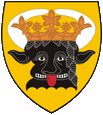
14th cent.,
Coat of arms of Mecklenburg,
Source: Heraldique Europeenne
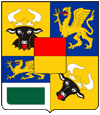
15th cent.,
Coat of arms of Mecklenburg,
Source:
Heraldique Europeenne
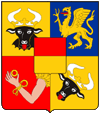
16th cent.,
Coat of arms of Mecklenburg,
Source:
Heraldique Europeenne

17.-18th cent.,
Coat of arms of the Duchies of Mecklenburg-Guestrow and Mecklenburg-Schwerin,
Source: Wernigeroder Wappenbuch 140.jpg: AnonymousUnknown authorWappen Schild Blank.svg: UnreifeKirsche, OwenBlackerWappen Geteilt Blank.svg:Wappen Schild Blank.svg: UnreifeKirsche, OwenBlackerderivative work: OwenBlackerDuke of Mecklenburg-Strelitz Arms.svg: A1 AardvarkBlason Seigneurs de Stargard.svg: Jimmy44POL województwo łódzkie II RP COA.svg: Poznaniak i Bastianderivative work: OwenBlacker [Public domain]
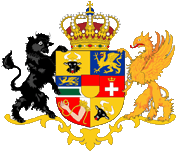
19th cent. to 1918,
Coat of arms of Mecklenburg-Strelitz,
Source: HGISG Geoinform
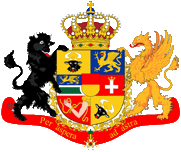
19th cent. to 1918,
Coat of arms of Mecklenburg-Schwerin,
Source: Wikipedia (D)
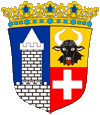
1918–1934,
Coat of arms of the Free State of Mecklenburg-Strelitz,
Source: Wikimedia.org
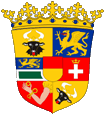
1918–1934,
Coat of arms of the Free State of Mecklenburg-Schwerin,
Source: Otto Hupp, PNG durch David Liuzzo [Public domain]

1934–1945,
Coat of arms of Mecklenburg,
Source:
Wikipedia (D)
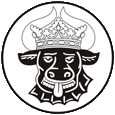
1948–1952,
Seal of Mecklenburg,
Source: See page for author [Public domain]

The coat of arms of the Lords of Mecklenburg showed originally a griffin, but from 1219 a black head of a bull, with neck fur, on a golden background. From the 14th Century, a quartered shield was used, which showed the possessions and acquisitions of the House of Mecklenburg. These heraldic pictograms appeared over the times again and again or became supplemented. Initially these were the bull head – with neck fur – on gold for Mecklenburg, a golden griffin on blue (Rostock), a between blue and white splited field, in the upper blue, a golden griffin, the lower a green field (Principality of Schwerin), an oblique bull's head – without neck fur – on gold (Werle), a between red and gold splited field, also used as central shield (County of Schwerin). From the 16th century there appeared an arm, holding a gold ring, on red (Stargard), and from the 17th century even a crowned silvery cross on red (Ratzeburg).
Between the lines of Mecklenburg-Guestrow and Mecklenburg-Schwerin there was no difference in the coat of arms, because the dukes of the two principalities shared not only the title, they also used the same coat of arms, and the same colours. This was handled in the same way between Mecklenburg-Schwerin and Mecklenburg-Strelitz, , but nevertheless there are some small differences in the coats of arms: 1.) In the red field of the Principality of Ratzeburg, the crown does not sit directly on the cross, at the coat of arms of Mecklenburg-Strelitz, but with a little distance above it. 2.) In the red field of the Lordship of Stargard, the arm does not directly come from the edge of the field, at the coat of arms of Mecklenburg-Strelitz, but first out of a cloud. 3.) In the large coat of arms are placed three crowned helmets above the shield, the middle helmet bears at the coat of arms of Mecklenburg-Strelitz no ordinary crown but a so-called Wendish crown (more like a hoop) and the piles there looking out have the color sequence of black, red, gold, blue, silver instead of black, gold, red, silver, blue (at Mecklenburg-Schwerin) and the bull's head behind them is not placed on a golden shield, as at Mecklenburg-Schwerin. 4.) In the large coat of arms, the shield-holding bull shows no tongue and the griffin has not raised the tail but down between the legs at the coat of arms of Mecklenburg-Strelitz. 5.) The order-chain and the banner appear only in the coat of arms of Mecklenburg-Schwerin. 6.) In the large coat of arms, the canopy of the tent of the coat of arms of Mecklenburg-Strelitz shows no ornaments. Often it is noticeable in historical representations of the large and middle coats of arms that the two shield holders (supporters), Bull and Griffin, either look inward or both looking outwards. This difference is not important (according to Ströhl), but followed – changing over the times – a particular taste, however, when the shield holders last looking inward (ca. 1895). The golden coat of arms with the bull's head was retained over all times as the lesser coat of arms.
After the monarchy was abolished, Mecklenburg-Strelitz and Mecklenburg-Schwerin was both a Free State, and in 1918 took both to establish their own new coat of arms. The coat of arms of Mecklenburg-Strelitz was splited and half-divided, it showed to the left in blue a crenellated silvery wall with a pointed roofed crenellated tower (Stargard), upper right on gold a black bull's head with neck fur (Mecklenburg), bottom right on red a silvery cross (Ratzeburg ). Above a "people's crown". When we compare the heraldic pictograms with those from before 1918, it is striking, that crowns are no longer present. The coat of arms of Mecklenburg-Schwerin remained mostly intact. Only the Grand Ducal crown on the coat of arms was replaced by a "people's crown". Even the known heraldic pictograms have retained their crowns.
In 1934 Mecklenburg-Schwerin and Mecklenburg-Strelitz were merged to the Country of Mecklenburg, and as coat of arms was adopted the former central shield with the heraldry of the County of Schwerin. For the Country of Mecklenburg the Soviet Occupation Zone and in the GDR was only introduced a seal in 1948, what showed the bull's head. There was no introduction of a coat of arms until the end of the country in 1952, because they reached no agreement about the new design, because after all, the country in 1945 has been significantly increased with the connection of Western Pomerania. After the country was re-founded as Mecklenburg-Western Pomerania in 1990 there was introduced a new emblem in 1991 (click here).
Source, by:
Deutsche Wappen Rolle,
Wikipedia (D),
Heraldique Europeenne,
HGISG Geoinform,
Volker Preuß

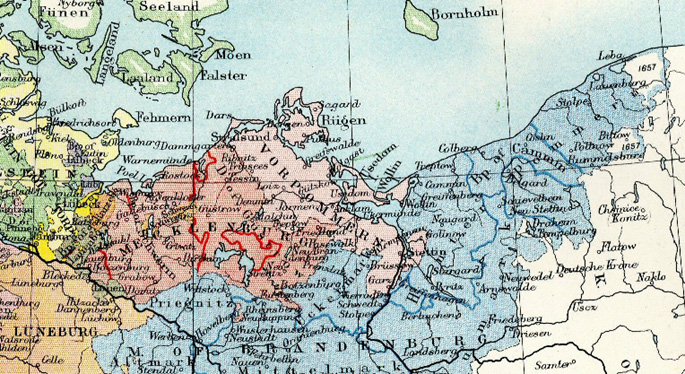
Source: Historical Atlas of Modern Europe, 1902, by R. Lane Poole
The map shows Mecklenburg (brown), Swedish-Pomerania (light brown), and Pomerania (blue) as a possession of Brandenburg, in 1648. The red lines are the former border between Mecklenburg-Schwerin and Mecklenburg-Guestrow.

Area: 6.070 square miles
Inhabitants: 910.000 (1939)
Density of Population: 150 inh./sq.mi. (1939)
Capitals and Residencies: Schwerin, Güstrow, Neustrelitz, Schwerin is the capital since 1939
Currency 1848–1867: 1 Taler = 48 Schillinge
Currency 1868–1871: 1 Taler = 30 Groschen
Currency 1871–1924: 1 Mark = 100 Pfennig
Currency 1924–1948: 1 Reichsmark (RM) = 100 Reichspfennig (Rpf.)
Source: Wikipedia (D),
Der Michel,
HGISG Geoinform,
Volker Preuß

about Christ's birth · in the region settles the Germanic tribe of the Warnen
375 · Hun invasion, the beginning of the Great Transmigration (Migration Period), migration of the old Germanic tribes into the Roman Empire, moving up of other Germanic tribes towards the Roman border, in the region settles now the Germanic tribe of the Lombards, in the 5th century they move in southeastern direction, in the now deserted area (Germania Slavica) immigrate Slavs, in the region of the today's Mecklenburg are this from the 7th century on, Slavs from the tribes of the Obodrites, the Wilzen and the Lutizen.
about 900 · in the East Frankish Kingdom forme out five tribal duchies (Saxony, Bavaria, Swabia, Franconia and Lorraine), the beginning of the eastward expansion into Germania Slavica between the rivers Saale/Elbe and the Oder/Neisse, the Elbe river becomes crossed to the north-east, and about 960 the Baltic Sea and the Oder River are reached, the Obodrites, Wilzen and Lutizen become annexed to the Mark (Margraviate) of Hermann Billung
983 · Slavic rebellion, the Mark of Hermann Billung is lost again
995 · Slavic rebellion is supressed, in the following years emerges a Slavic principality under the Obodrites dynasty of the Lords of Mecklenburg
1167 · Prince Pribislav takes the country from Heichrich the Lion (Guelph) as a fiefdom
from 13th century · immigration of German settlers
1214–1227 · the Kingdom of Denmark occupies the coast of the country
1226 · inheritance, thus arise of the Principalities of Mecklenburg, Werle, Parchim and Rostock
1256 · split of the Principality Parchim
1317 · Mecklenburg gets the Lordship of Stargard
1323 · Mecklenburg gets the Principality of Rostock
1347 · the Princes of Mecklenburg get Stargard get as an imperial fiefdom, become in this way levied from princes to dukes
1348· the Princes of Mecklenburg get Mecklenburg as an imperial fiefdom
1352· the Dukes of Mecklenburg divide their land into the Duchies of Mecklenburg and Stargard
1358 · the Duke of Mecklenburg gets the Town of Schwerin and moves the residence there
1436 · extinction of the Princes of Werle, the inheritance goes to the Duchy of Mecklenburg
1471 · extinction of the Dukes of Stargard, the inheritance goes to the Duchy of Mecklenburg, Mecklenburg thus reaches the expansion of modern times
1549 · official introduction of the Reformation
1618–1648 · Thirty Years' War in the Holy Roman Empire of the German Nation, 70% of the population of Mecklenburg are murdered or die
1621 · division of the duchy in Mecklenburg-Schwerin and Mecklenburg-Guestrow
1625 · the Lutheran dukes form an alliance with the King of Denmark against the Catholic Emperor
1627 · the Lutheran dukes become deducted by the emperor, establishing of Albrecht Wenzel Eusebius of Wallenstein as new Duke
1629 · the former dukes call the King of Sweden into the country
1630 · the King of Sweden seats the Dukes of Mecklenburg back on their throne
1632 · Mecklenburg sedes Wismar Town to Sweden (officially from 1648, and until 1803)
1635 · re-recognition of the Dukes by the Emperor
1658–1721 · Mecklenburg is a battefield in the Nordic Wars
1695 · extinction of the line of Mecklenburg-Guestrow, inheritance disputes
1701 · Hamburg Comparison, re-division of the country into the Duchies of Mecklenburg-Schwerin and Mecklenburg-Strelitz (for more history look further there)
...
1st of January in 1934 · unification of Mecklenburg-Schwerin with Mecklenburg-Strelitz to the Country of Mecklenburg
1933–1934 · Mecklenburg cedes (like all German states) its exclusive pilitical rights to the government of the empire, the territorial structure of the German Empire countries become replaced by the Gau structure of the NSDAP, the countries become meaningless, finally on 30th January in 1934 by the 'Law on the rebuilding of the empire'
9th of July in 1945 · initially occupation by US-american, British and soviet troops, thereafter withdrawal of the British and US-Americans, merge of Mecklenburg with West Pomerania and smaller areas of Brandenburg and Hannover to the Country of "Mecklenburg-WestPomerania" within the soviet occupation zone
Source: Atlas zur Geschichte,
Wikipedia (D),
Discovery '97,
HGISG Geoinform,
Volker Preuß,
Jürgen Kaltschmitt

The name Mecklenburg was first mentioned in a document from the year 995 as 'Mikelenburg'. With this name was meant a Slavic castle with the name 'Wiligrad'. Its name was translated into Low German language. Because 'Wiligrad' means in the language of the Obodrites and in Low German language "big castle" ("miekel" = big). The Lords of the Mikelenburg had been princes out of the tribe of the Obodrites and later they became the chiefs of the whole country and even imperial princes. The ruled until 1918.
Source: Wikipedia (D),
Volker Preuß







![]()























